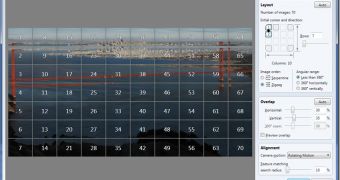A new iteration of the Image Composite Editor from Microsoft Research is currently available for download from the company, as the tool evolved up to version 1.3. There are a variety of new features and capabilities that end users can explore while running the software giant’s software designed to allow the stitching of images together in order to create panoramic imagery. Those already familiar with the project will be able to use Image Composite Editor 1.3 in order to process 16-bit images. At the same time, Microsoft has worked in order to allow users to leverage ICE in concert with Photosynth. Essentially, panoramic images stitched together with ICE can now be shared as synths via Photosynth.
“The Photosynth web site has been enhanced to let users interact with massive, fully immersive panoramas. Photosynth uses intelligent streaming technology that allows for smooth pan and zoom of even the largest images. This is a huge step forward compared to how most ICE users have been sharing their panoramic creations on the web. The best way to understand this is to check out a few examples uploaded from ICE this morning,” the ICE Team, Matt Uyttendaele, Eric Stollnitz, and Howard Good, revealed.
As of version 1.3, Image Composite Editor also allows users to add geographic tags to their panoramas. According to the Redmond company, ICE 1.3 comes with a range of geotagging capabilities, allowing for a variety of information to be stored along with the actual image, including location, direction. In addition, photographers will also be able to add “General” tags and even a text description to photos. More importantly, because of geotagging, the panoramas that have become synths will be offered by Microsoft in Bing Maps to users alongside plain vanilla synths.
“At Microsoft Research we’ve been working on creating super high resolution images for a few years now. Some of this technology was in the first version of ICE, but it wasn’t really possible to create multi-gigapixel images with ICE — until now! We’ve added a new type of project in ICE called a structured panorama. This is accessed via the “File: New Structured Panorama” menu, which allows you to give ICE some hints about the order of your input images,” Uyttendaele added.
Of course that dealing with multi-gigapixel images will place quite a strain on the hardware resources available to users. In this regard, ICE’s evolution means that the tool is now tailored to multi-core PCs, with its processing-intensive tasks optimized to be spread across several CPU cores.
Image Composite Editor 1.3 is available for download here.

 14 DAY TRIAL //
14 DAY TRIAL //